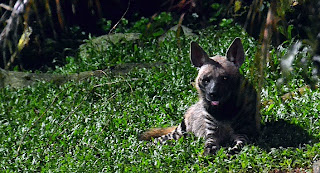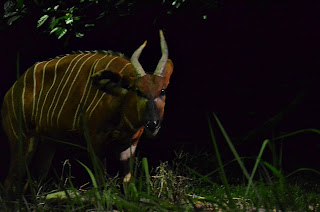Another
en-chanting morning. The drums started at 4.45am.
Still a
magical light with the halogen street lights adding to the glow.
This morning
the monks were accompanied by a pack of dogs.
After breakfast
the team headed off to work while I decided to walk around the city.
I asked about a
cab to the National Museum and it was pointed out that it
was only a short walk
away. So off I went.
Opposite the
National Museum is the National Cultural Hall. A truly ugly,
monumental
building that was built by the Chinese Government as a “gift for
the people of
Laos”. It was opened in 2000 but unfortunately the Chinese
Government didn’t
include in their gift an operating budget. This means it is
rarely opened and
is only used for visiting artists and government conferences.
I feel they
would have done a much better job by investing in an upgrade of
the National
Museum. I couldn’t photograph inside the museum and I’m not
sure why. It is an
interesting museum but it is very, very sad. The photographs
are fading and are
suffering water damage and insect infestation. The dioramas
are rather dusty.
The exhibition labelling is occasionally in French, occasionally
in English and
occasionally in Lao, these are also fading and hard to read.
Whenever America is mentioned it is as “the American imperialists and their
puppets”. The Lao
story is so dramatic that money spent on making it all so
much more engaging
would be wonderful.
After the museum
I walked to the Nam Phou Fountain as I had been told that
there were plenty of restaurants
around a lovely fountain. I found a few cafes
facing a walled-off, dusty construction
site. I ended up at Khop Chai Deu for lunch.
I knew it was time to leave when a
group of young Australian males sat down at
the next table and ordered a bottle
of bourbon for lunch.
Before the trip
I had been asked to buy a traditional silk sarong. So that was the
next task. I
went into many small shops, tourist and non-tourist and could only
find tat. I
got on the web and found Mixay, which was recommended for using local
weavers, it
close to the hotel so I dropped in. I asked the owner about sarongs
and she
directed me to the local markets. I explained that I was after a traditional
sarong. She only had two and I bought one. The design was exquisite.
We had an
interesting conversation that should be a lesson for tourists in
developing
countries. She told me that her local products supported women’s
groups in
Laos, but that traditional weaving was expensive by Lao standards,
and tourists
were after bargains. What they were buying was brought in from
China and
Thailand. The fabrics were of a lower standard (I can attest to that),
the
profits went out of the country and local industry was not supported. So
please when you want some object to remind you of a particular trip, find
locally produced goods. Don’t send your money to another country.
I bought a few
other things that demonstrated the beautiful embroidery
and weaving of Laos.
Another thing
for travellers is the idea of having to bargain for everything.
If you are in a
high-end shop go for it and good luck. But if you are at a street
stall or
market think about it. In Laos, $Aus1.00 equals approximately Kip 8,500.
So
when you spend fifteen minutes bargaining an item down from Kip 17,000
to
8,500, you’ve wasted fifteen minutes for the bragging rights of saving $1.00,
that you could well afford, and probably means an awful lot to the vendor.
Remember that you are probably buying counterfeit or illegally downloaded
material yourself. Don’t get ripped off but don’t be an ugly tourist.
I meandered back to the hotel.
That night our
client took us to a charming French Restaurant that could
have been anywhere in
the world. The food was delicious, the wine wonderful
and the company
entertaining.
As I retire for
the night I ponder that the British left their colonies with the
Westminster system
of government and law, brass bands and cricket.
The French left their colonies
with a taste for fine wine, great cuisine and the
ability to make melt in the
mouth croissants.
Hmmm....which
would I prefer?




















































